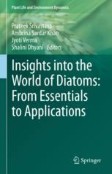Search
Search Results
-
Terrestrial mosses as a substrate and potential host for cyanobacteria, green algae and diatoms
Most studies of terrestrial bryophytes as natural substrates for photosynthetic microorganisms have been performed in the polar regions, where...

-
Invasive submerged plant has a stronger inhibitory effect on epiphytic algae than native plant
The invasion of submerged aquatic plants potentially results in a loss of native biodiversity in these ecosystems. There has been little attention...

-
The succession of epiphytic microalgae conditions fungal community composition: how chytrids respond to blooms of dinoflagellates
This study aims to investigate the temporal dynamics of the epiphytic protist community on macroalgae, during the summer months, with a specific...

-
New Perspectives in Sustainable Bioconversion of Lignocellulose to Biofuel by Diatoms
Organic carbon may be obtained sustainably from lignocellulosic biomass; however, the majority of microorganisms, including microalgae, find it...
-
Multiple anthropogenic pressures and local environmental gradients in ponds governing the taxonomic and functional diversity of epiphytic macroinvertebrates
Anthropogenic activities alter community composition, diversity and functioning of macroinvertebrate communities in freshwater ecosystems. Especially...

-
Host seaweed extracts effect on epiphytic Acrochaetium sp growth and its phycobilipigments content and biological activity
The association of microscopic epiphytic algae with marine macroalgae (seaweeds) hosts is common. One such epiphyte is Acrochaetium species and its...

-
An ecological analysis of lacustrine diatoms in Costa Rica
In many regions, the utility of diatoms as paleoenvironmental indicators is limited by insufficient ecological knowledge of the local modern species....

-
The Mechanism of Ecosystem Restoration and Resilience of Present-Day Coastal Lagoons by Coastal Diatoms and Their Implications for the Management of Successional Diatomite Landscapes
Diatoms of coastal lagoons have been known to be excellent proxies of their environmental changes and are excellent proxies for eco-resilience given...
-
Composition and Ecological Characteristics of Diatoms of Algocenoses in the Benthal of the Mouth of a Large Eutrophic–Hypertrophic River (Oka River, Russia)
AbstractThe composition, taxonomic structure, and ecological indicators of bottom diatoms in the mouth of a large eutrophic–hypertrophic river are...

-
The effects of early spring stocking in an agricultural lake: a trophic cascade hypothesis
Lake Jošava (Croatia) is a shallow reservoir surrounded by agricultural land. In the present study, the trophic cascade was tested by examining the...

-
Effect of the structural complexity of aquatic macrophytes on epiphytic algal, macroinvertebrates, and their interspecific relationships
Aquatic macrophytes may have a significant effect on associated communities such as epiphytes and macroinvertebrates, which through the structural...

-
Spatial analysis of diatom diversity and water chemistry of ropar wetland (Ramsar site) of Punjab, India
The monitoring of wetlands is essential as they provide significant ecosystem services to our biosphere. Diatoms are widely distributed, species rich...

-
Diatom-Diazotroph Associations in hydrographically defined habitats of the South China Sea
The South China Sea (SCS) is a hydrographically complex and physically dynamic marginal sea of great economic importance. Primary production in the...

-
A tripartite model system for Southern Ocean diatom-bacterial interactions reveals the coexistence of competing symbiotic strategies
Southern Ocean (SO) diatoms play an important role in global carbon flux, and their influence on carbon export is directly linked to interactions...

-
Trophic and saprobic diatom-based indices are not indicating the same ecological status in a shallow lake, Türkiye
This study aimed to assess the ecological health of a RAMSAR site lake by leveraging diatoms as ecological indicators. Utilizing six trophic and four...

-
Epiphytes support aquatic consumers of a large floodplain lake ecosystem in the southern Gulf of Mexico
Floodplain lakes are highly productive and biodiverse ecosystems whose food webs depend on a variety of autochthonous and allochthonous resources....

-
Benthic Diatoms of the Russian Waters of the Sea of Japan and Adjacent Sea Areas
AbstractThis review analyzes the current state of knowledge of the microphytobenthos in the Russian waters of the Sea of Japan and adjacent sea...
-
Advancing potential of diatom indicators for stream and lake water quality assessment against nutrient-induced pollution
Algae have a long history of use in indicating ecological condition of streams and lakes. Various algae-based indicators have been developed and used...

-
Scarus spinus, crustose coralline algae and cyanobacteria: an example of dietary specialization in the parrotfishes
Niche differentiation is a key stabilizing mechanism in the maintenance of biodiversity and species coexistence. Recent work shows that trophic niche...

-
Moss-inhabiting diatoms as ecological indicators in Neora Valley National Park (Eastern Himalaya), India
Terrestrial mosses which retain moisture provide a suitable ambience for diatoms colonization and suitable experimental platforms for observing...

